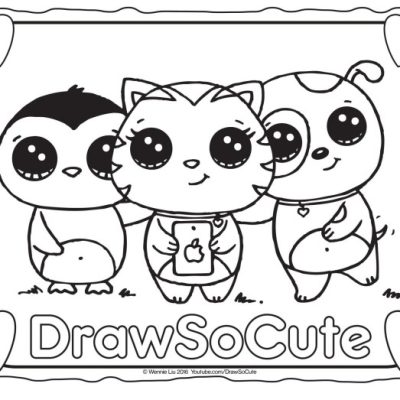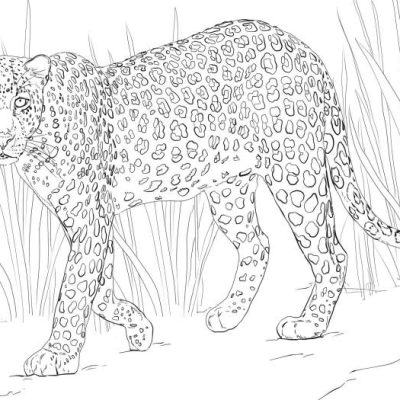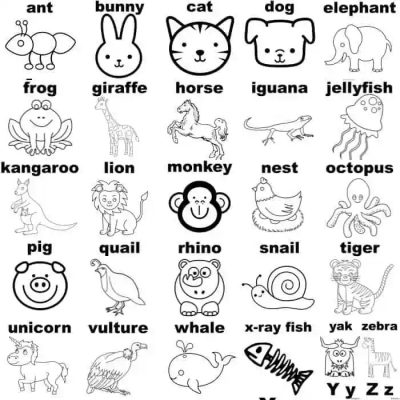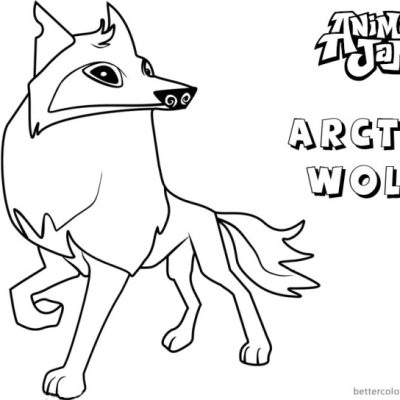Animal Alphabet Coloring Page A Wild Adventure

Design Considerations

Creating an engaging and educational animal alphabet coloring page requires careful consideration of design elements to ensure it’s both visually appealing and functional for its young audience. The design should balance the need for clear letter-animal pairings with vibrant illustrations that spark creativity and learning.The design concept centers around a bright and cheerful aesthetic, using a layout that’s easy for children to navigate and color.
The diverse selection of animals will represent a broad range of species, promoting inclusivity and expanding children’s knowledge of the animal kingdom.
Layout and Structure
The page will utilize a table-based layout for optimal organization and responsiveness across different screen sizes. This approach allows for a clean presentation of the alphabet and corresponding animal illustrations. A grid-like structure, utilizing a responsive 4-column table, ensures that the content remains well-organized and easily accessible, even on smaller screens. Each cell will contain a letter of the alphabet followed by a simple, yet detailed, illustration of the animal.
For example:
| A – Alligator | B – Bear | C – Cat | D – Dog |
| E – Elephant | F – Fox | G – Giraffe | H – Horse |
| I – Iguana | J – Jackal | K – Kangaroo | L – Lion |
| M – Monkey | N – Narwhal | O – Owl | P – Penguin |
| Q – Quetzal | R – Rabbit | S – Seal | T – Tiger |
| U – Unicorn | V – Vulture | W – Whale | X – X-ray Tetra |
| Y – Yak | Z – Zebra |
This table layout provides a clear and structured presentation, ensuring that each letter and animal pairing is easily identifiable. The use of four columns ensures that the page isn’t overly long, maintaining child engagement. The empty cells at the end are for flexibility and potential future expansion. Consideration will be given to adjusting the number of columns based on the overall size and complexity of the animal illustrations.
Color Palette Selection
The color palette will be carefully chosen to be both visually appealing and appropriate for the target audience of young children. Bright, primary colors will be predominantly used, with secondary and tertiary colors used for shading and detail to create visual interest without being overwhelming. Pastel shades will be incorporated sparingly to provide a softer contrast and avoid overwhelming the page with intense colors.
The background will utilize a light, neutral color such as a pale yellow or light beige to provide a clear contrast to the animal illustrations and text. This ensures the coloring page remains visually stimulating but not overly distracting, allowing the focus to remain on the learning aspect. The color choices will also consider the association of colors with different animals, for example, using earthy tones for animals such as bears and lions, and brighter colors for animals such as parrots and monkeys.
This will contribute to the realism and overall appeal of the coloring page.
Animal Selection and Illustration: Animal Alphabet Coloring Page

Bringing the alphabet to life through the vibrant world of animals requires careful consideration of both species diversity and visual appeal. Our goal is to create a coloring page that is both educational and engaging for young children, fostering a love for animals and the alphabet simultaneously. The illustrations must be simple enough for children to easily color, yet detailed enough to be recognizable and charming.This section details the animal selection for each letter of the alphabet, along with a description of the proposed illustration style for each.
We prioritize simplicity, clarity, and visual appeal, ensuring each animal is easily identifiable and fun to color.
Animal Selection and Illustration Details, Animal alphabet coloring page
Below is a list of 26 animals, one for each letter of the alphabet, along with a description of their illustration style. The illustrations will employ a clean, child-friendly style, emphasizing simple shapes and bold Artikels. Each animal will be presented in a positive and engaging posture.
- A – Aardvark: Aardvark depicted in profile, digging with its powerful claws. Size will be medium, showing its long snout and ears clearly. Simple, rounded shapes will be used for its body.
- B – Baboon: A playful baboon sitting upright, looking directly at the viewer. Size will be medium, showcasing its characteristic facial features and fur. Simplified fur texture will be used.
- C – Capybara: A relaxed capybara lying down, showing its large size and rodent-like features. Size will be large, emphasizing its relaxed posture. Simple, smooth lines will define its body.
- D – Dolphin: A leaping dolphin, showcasing its sleek body and powerful tail. Size will be medium, highlighting its streamlined shape. Smooth curves will depict its body.
- E – Elephant: A side profile of an elephant, showing its trunk and large ears. Size will be large, showcasing its majestic size. Simple, rounded shapes will be used for its body.
- F – Fennec Fox: A curious fennec fox sitting upright, with its large ears pointed. Size will be small, highlighting its adorable features. Simple lines and shapes will define its features.
- G – Giraffe: A giraffe standing tall, showing its long neck and spotted pattern. Size will be large, emphasizing its height. Simple spots will be used for its coat.
- H – Hedgehog: A curled-up hedgehog, showing its spiky quills. Size will be small, emphasizing its round shape. Simple, spiky lines will represent its quills.
- I – Iguana: An iguana basking in the sun, showing its scales and long tail. Size will be medium, highlighting its textured skin. Simple scales will be used to texture its skin.
- J – Jackal: A jackal in a running pose, showcasing its lean body and sharp features. Size will be medium, emphasizing its agile form. Simple lines will define its musculature.
- K – Kingfisher: A kingfisher perched on a branch, showing its vibrant colors. Size will be small, emphasizing its details. Simple shapes and bold colors will be used.
- L – Llama: A llama standing calmly, showcasing its fluffy coat. Size will be medium, emphasizing its soft fur. Simple, fluffy lines will represent its coat.
- M – Meerkat: A meerkat standing upright, looking alert. Size will be small, highlighting its inquisitive expression. Simple lines and shapes will define its body.
- N – Narwhal: A narwhal swimming, showing its distinctive tusk. Size will be medium, emphasizing its unique feature. Simple lines will define its body.
- O – Owl: An owl perched on a branch, showing its large eyes and rounded body. Size will be medium, highlighting its wise appearance. Simple shapes will define its body.
- P – Penguin: A penguin standing upright, showing its black and white plumage. Size will be medium, highlighting its distinctive markings. Simple shapes will define its body.
- Q – Quetzal: A quetzal perched on a branch, showing its long tail feathers. Size will be medium, highlighting its vibrant colors and long tail. Simple shapes and bold colors will be used.
- R – Rabbit: A rabbit sitting upright, showing its long ears and fluffy tail. Size will be small, highlighting its cute features. Simple shapes will define its body.
- S – Sloth: A sloth hanging from a branch, showing its slow and relaxed posture. Size will be medium, highlighting its relaxed form. Simple lines will define its body.
- T – Tiger: A tiger walking, showing its stripes and powerful body. Size will be large, emphasizing its strength. Simple stripes will be used for its coat.
- U – Urial: An urial standing, showcasing its curved horns. Size will be medium, emphasizing its wild nature. Simple lines will define its body and horns.
- V – Vulture: A vulture perched on a rock, showing its sharp beak and powerful talons. Size will be medium, highlighting its predatory features. Simple shapes will define its body.
- W – Walrus: A walrus lying down, showing its tusks and blubber. Size will be large, emphasizing its massive size. Simple shapes will define its body.
- X – X-ray Tetra (stylized): A stylized representation of an X-ray Tetra, highlighting its transparent body. Size will be small, emphasizing its unique feature. Simple lines and transparent areas will be used.
- Y – Yak: A yak standing, showing its long shaggy coat and horns. Size will be medium, emphasizing its thick fur. Simple, fluffy lines will represent its coat.
- Z – Zebra: A zebra standing, showing its distinctive stripes. Size will be medium, highlighting its black and white markings. Simple stripes will be used for its coat.
Learning the alphabet can be a playful adventure, especially with an animal alphabet coloring page. To deepen understanding, consider exploring how these animals thrive; for example, check out this fascinating animal adaptations coloring page to see how their unique features help them survive. Then, return to your animal alphabet coloring page with a newfound appreciation for the incredible diversity of the animal kingdom.









